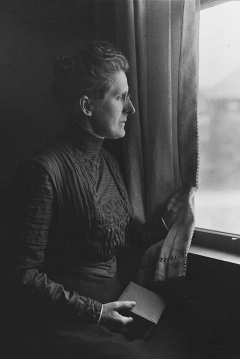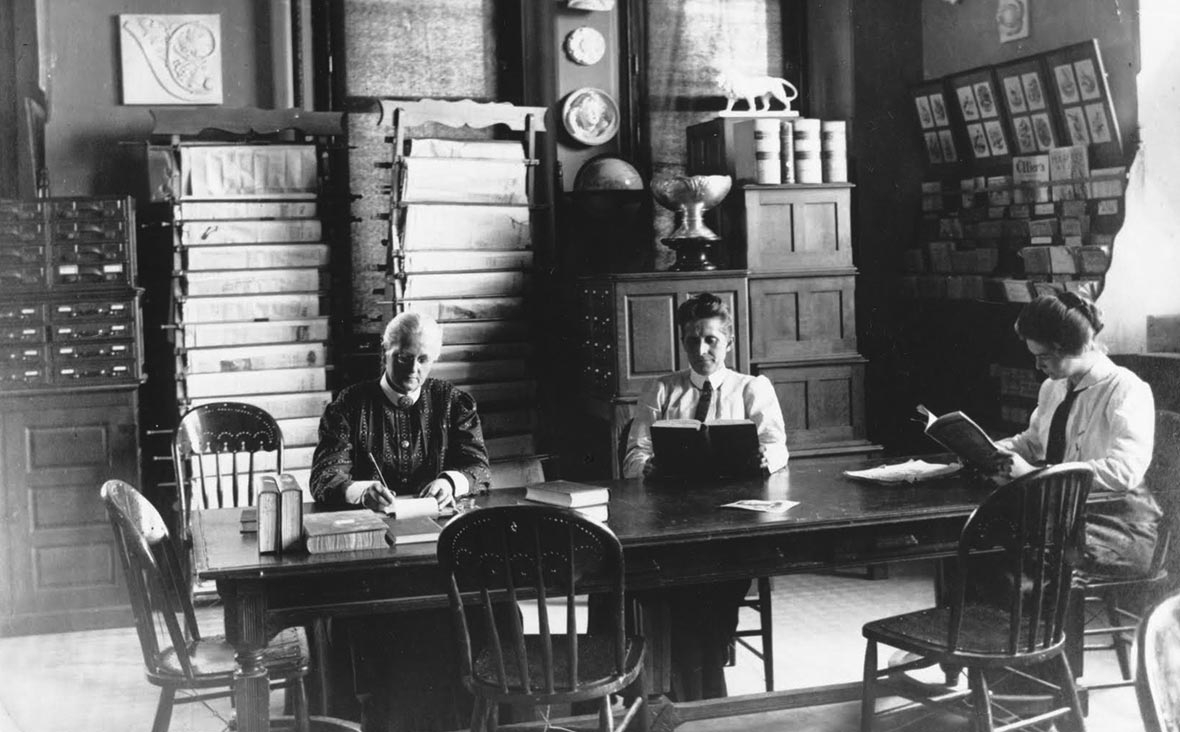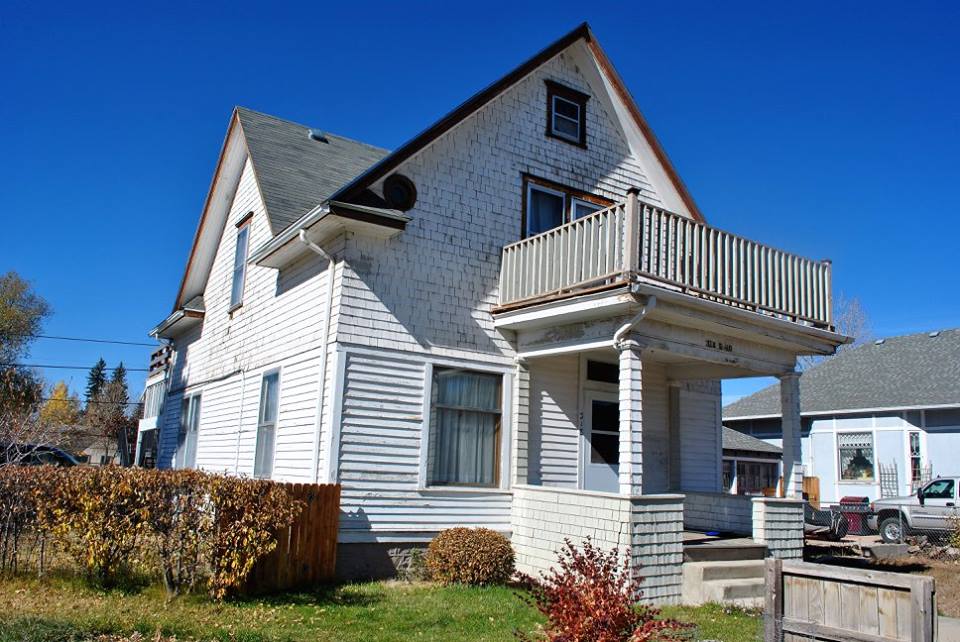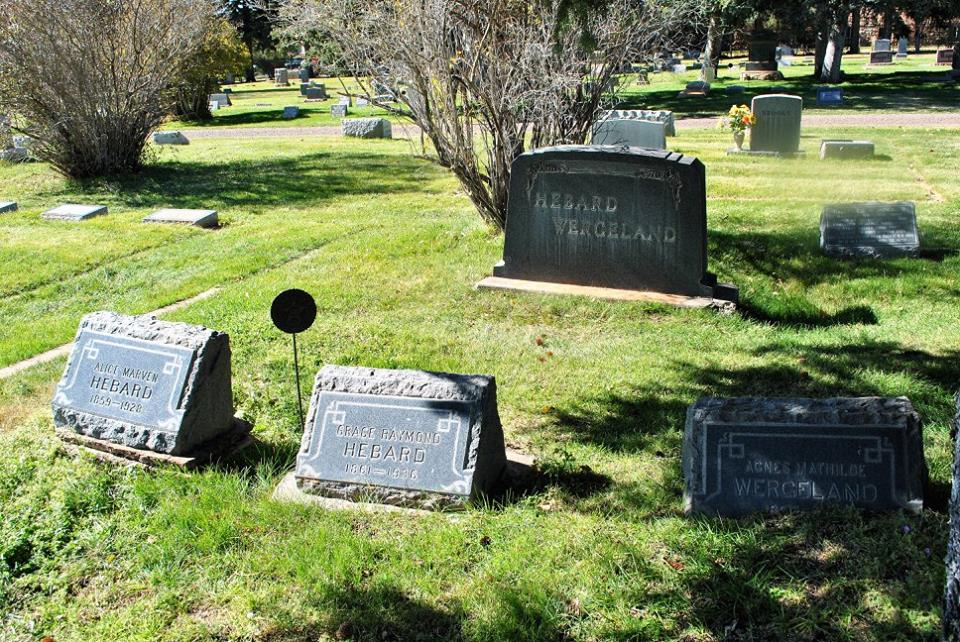BURIED TOGETHER
Partner Agnes Wergeland, buried together
Queer Places:
Illinois Wesleyan University, 1312 Park St, Bloomington, IL 61701, Stati Uniti
University of Iowa, Iowa City, IA 52242, Stati Uniti
318 S 10th St, Laramie, WY 82070, Stati Uniti
Greenhill Cemetery, Laramie, Wyoming 82072, Stati Uniti
 Grace Raymond Hebard (July 2, 1861 – October 1936) gained prominence as a
Wyoming historian, suffragist, pioneering scholar, prolific writer,
political economist and noted University of Wyoming educator. Hebard's
standing as a historian in part rose from her years trekking Wyoming's high
plains and mountains seeking first-hand accounts of Wyoming's early
pioneers. Today her books on Wyoming history are sometimes challenged due to
Hebard's tendency to romanticize the Old West, spurring questions regarding
accuracy of her research findings. In particular, her conclusion after
decades of field research that Sacajawea (participant in the Lewis and Clark
Expedition) was buried in Wyoming's Wind River Indian Reservation is called
into question.[1]
Grace Raymond Hebard (July 2, 1861 – October 1936) gained prominence as a
Wyoming historian, suffragist, pioneering scholar, prolific writer,
political economist and noted University of Wyoming educator. Hebard's
standing as a historian in part rose from her years trekking Wyoming's high
plains and mountains seeking first-hand accounts of Wyoming's early
pioneers. Today her books on Wyoming history are sometimes challenged due to
Hebard's tendency to romanticize the Old West, spurring questions regarding
accuracy of her research findings. In particular, her conclusion after
decades of field research that Sacajawea (participant in the Lewis and Clark
Expedition) was buried in Wyoming's Wind River Indian Reservation is called
into question.[1]
Yet Hebard didn't let critics limit her. She served as the first female
on the University of Wyoming Board of Trustees, where she exercised
authority over the university finances, its president, and faculty.[2]
Her University of Wyoming role extended to establishing the university's
first library. Moreover, Hebard served as a professor for 28 years. Hebard
also broke new ground when she became the first woman admitted to the
Wyoming State Bar Association (1898);[3]
admitted to practice before the Wyoming Supreme Court (1914); and
appointed by her peers as vice president of the National Society of Women
Lawyers.[4]
Whether it be as a legal professional, educator, or feminist, the Iowa
native spearheaded her own one-woman progressive movement. The range rider
seemed to be constantly on the stump in Wyoming giving speeches,
organizing historical associations, conducting citizenship classes for
immigrants, participating in the local and national suffragist movement,
lobbying for child-welfare laws, serving as a Red Cross volunteer, and
traveling the state selling war bonds during World War I.


The Doctors' Inn, Laramie

Greenhill Cemetery, Laramie

University of Wyoming, Laramie
Hebard's activism placed her against the prevailing social and
political winds that swept through Wyoming and the nation. The way Hebard
lived her feminist life, including her deep relationship with fellow
Professor Agnes
M. Wergeland, spoke volumes about her worldview. Wergeland, like
Hebard a feminist, was a trail breaker in her own right. The Norwegian
immigrant was the first woman from her country to earn a Ph.D.[3]
Wergeland, who became a U.S. citizen in 1902, found in Hebard an ideal
tutor for Americanization. Hebard noted: "Dr. Wergeland had never had a
realistic conception of what absolute suffrage for women meant until she
came to Wyoming, where women are not restricted in their right to vote in
any way."[19]
Grace Hebard retired from teaching in 1931. Yet she continued to
research and collect historical material in her Laramie home, known to
students and colleagues as "The Doctors Inn". Hebard lived in this house
that she had had built with her friend, Agnes Wergeland, who died in 1914.
Grace's sister Alice Marvin Hebard then lived there until her death in
1928.
The intrepid Hebard is buried across the street from campus at the
Greenhill Cemetery in Laramie in a plot near her sister and teacher,
Alice, and Wergeland. A plaque memorializing Hebard is mounted on the
famed Oregon Trail icon, Independence Rock; located in barren central
Wyoming, about 50 miles southwest of Casper.
My published books:


BACK TO HOME PAGE

- https://en.wikipedia.org/wiki/Grace_Raymond_Hebard
 Grace Raymond Hebard (July 2, 1861 – October 1936) gained prominence as a
Wyoming historian, suffragist, pioneering scholar, prolific writer,
political economist and noted University of Wyoming educator. Hebard's
standing as a historian in part rose from her years trekking Wyoming's high
plains and mountains seeking first-hand accounts of Wyoming's early
pioneers. Today her books on Wyoming history are sometimes challenged due to
Hebard's tendency to romanticize the Old West, spurring questions regarding
accuracy of her research findings. In particular, her conclusion after
decades of field research that Sacajawea (participant in the Lewis and Clark
Expedition) was buried in Wyoming's Wind River Indian Reservation is called
into question.[1]
Grace Raymond Hebard (July 2, 1861 – October 1936) gained prominence as a
Wyoming historian, suffragist, pioneering scholar, prolific writer,
political economist and noted University of Wyoming educator. Hebard's
standing as a historian in part rose from her years trekking Wyoming's high
plains and mountains seeking first-hand accounts of Wyoming's early
pioneers. Today her books on Wyoming history are sometimes challenged due to
Hebard's tendency to romanticize the Old West, spurring questions regarding
accuracy of her research findings. In particular, her conclusion after
decades of field research that Sacajawea (participant in the Lewis and Clark
Expedition) was buried in Wyoming's Wind River Indian Reservation is called
into question.[1]




